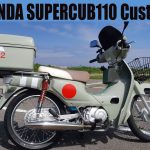In some cases, grease, which is supposed to be applied to improve sliding lubrication, reverses its role due to age-related deterioration and sticks like glue to fill in clearances. In such cases, people try to dissolve the sticking grease by spraying it with anti-corrosion spray to improve movement, but in many cases, this is not enough. It is precisely in such cases that the use of "heat" often yields results beyond imagination.
Let us reconfirm the effectiveness of maintenance x heat utilization here.
If the bolt does not loosen, warm up the surrounding area.

It is said that disc rotors and brake pads can reach several hundred degrees during braking. In other words, brake-related parts should be designed to be heat resistant. This fact is reversed by the fact that heat can be used to facilitate the disassembly of each part during a complete overhaul. The bolts that fasten the caliper bodies, which are divided into right and left sections, often stick together after years of use.
In many cases, special tools alone won't work.


Even a standard toaster oven should be able to heat up small parts. If the oven is being replaced with a new one, it can be kept and used for maintenance. The size of a brake caliper or carburetor should be more than enough to use. If the body is heated to around 100°C during overhaul, it should work well as a disassembly setup. Use a lubrication penetrating chemical in conjunction.
Look out for the "CV-Junior" double-decker oven!



CARVEK has been supported by numerous users for its product development with infrastructure development related to maintenance and restoration environments in mind. The company's CV-Junior (CV Junior) is a high-temperature heat dryer that has acquired the PS Mark for safety and reliability. Unlike ordinary toaster ovens, its internal volume is large, with a double-decker size, and its main feature is the ability to control both temperature and time.
Temperature control feedback is available

Surprisingly few common tabletop toaster ovens are capable of temperature control, and with the simple thermometer included, you can check the actual temperature and adjust the temperature as you work. The timer can run for up to one hour, not to mention the continuous operation function! Many Sunday mechanics and even pro stores use this system. In winter, when chemical reactions are low, setting the temperature to about 40°C can produce chemical reactions equivalent to or better than those in summer. It is nice to know the actual temperature even when you need to be careful not to overheat.
POINT
Point 2 - Warming = Metal parts that change greatly with slight thermal expansion
Point 3 - For single parts make good use of oven-type tools.
There are several types of heat sources, including thermal power and indirect heat (hot air), which we usually use.
Another heat source that should not be overlooked is hot water.
For example, in the case of chemical products that are diluted with water, diluting them with hot water (about 60-70℃ is just right) activates the ingredients more actively, and in many cases, the cleaning and decomposition power is much higher than that of diluting with cold water. We have tried this before. When using undiluted rust remover for gasoline tanks by diluting the undiluted solution 10 times, it took a considerable amount of time to remove the rust in the tank with the cold water dilution. However, when the solution was diluted with 60-70°C hot water and injected into a gasoline tank, and then wrapped in a blanket to keep the tank cool, the rust could be completely removed in one night's treatment time, even with the same degree of rust as in the cold water treatment.
Moreover, the steel surface inside the tank shined beautifully. The cold water treatment had a darker surface, and the effect was clearly different from the cold water treatment.
Let us now turn our attention to the toaster oven. In a sense, this oven is an indispensable heat source for maintenance.
For example, even in the case of brake calipers that have tightening torque and yet the bolts do not loosen due to corrosion of the threads or thread-locking agents, heating the caliper body often loosens the sticking and results in a shortcut to removing the bolts. Although parts such as caliper piston seals and dust seals, as well as fastening bolts, are subject to replacement as part of the overhaul setup, there are many cases where bolts do not loosen easily in cold conditions and can be loosened without incident by warming up the caliper body.
When you want to heat parts that do not fit in size, you can use an industrial heat gun or a gas burner to heat the parts over an open flame. However, keep in mind that gas burners are overwhelmingly too hot and may burn surrounding parts or paint, etc. For such affected parts, it is common to use a general industrial heat gun to heat the parts.
The use of "heat" is extremely important and effective in motorcycle maintenance. And if used correctly, the results are often surprising. In order to enjoy tinkering with motorcycles and to obtain satisfactory results, it is important to develop a variety of ideas and put them into practice effectively.



